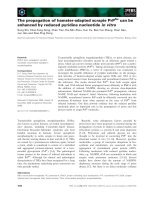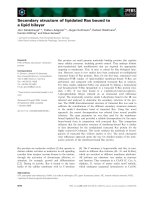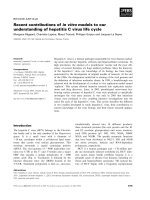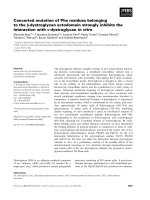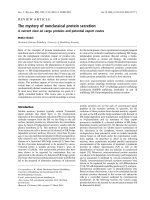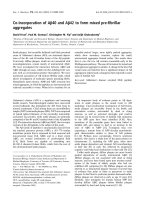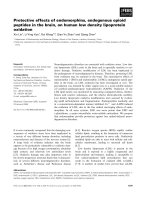Báo cáo khoa học: "Laparoscopic insertion of pelvic tissue expander to prevent radiation enteritis prior to radiotherapy for prostate cancer" pdf
Bạn đang xem bản rút gọn của tài liệu. Xem và tải ngay bản đầy đủ của tài liệu tại đây (619.96 KB, 6 trang )
CASE REP O R T Open Access
Laparoscopic insertion of pelvic tissue
expander to prevent radiation enteritis prior
to radiotherapy for prostate cancer
Gary D McKay
1
, Karen Wong
2
and Daniel R Kozman
1*
Abstract
Radiation enteritis is a significant complication of external beam radiotherapy (EBRT) to the pelvis, particularly in
patients having high dose radiotherapy (>80 Gy) and in those with a low pelvic peritoneal reflection allowing
loops of small bowel to enter the radiation field. Laparoscopic insertion and subsequent removal of a pelvic tissue
expander before and after external beam radiotherapy is a relatively convenient, safe and effective method for
displacing loops of bowel out of the pelvis. We report on a patient with prostate cancer who ordinarily would not
have been a candidate for EBRT due to loops of bowel low in the pelvis. With laparoscopic insertion and
subsequent removal of a tissue expander, he was able to have radiotherapy to the prostate without developing
radiation enteritis.
Introduction
Prostate cancer is the second most common cancer in
men. With the increasing u se of primary radiotherapy
for prostate cancer and improved survival, chronic
radiation enteritis is an increasing problem occurring in
over20%ofpatients[1].Theveryhighdosesof80Gy
radiotherapy required for prostate cancer, which is dou-
ble that given for most other pelvic malignancies, puts
those patients with a low peritoneal reflection and low-
lying loops of small bowel in the pelvis, at particular
risk of radiation enteritis.
Laparoscop ic insertion and subsequent removal of a
tissue expander before and after radiotherapy is a rela-
tively convenient and minim ally invasive procedure that
may be an option for displacing loops of bowel from the
radiation field.
Case Presentation
The patient was a 75 year old man with prostate cancer,
confirmed b y FNA to investigate a raised PSA. He had
stage 2 disease with a Gleason score of 3+4, and
required primary radiotherapy. He was relatively fit and
healthy, with a BMI of 29. He had a previous upper
midline laparotomy for gastric lymphoma, and open
appendicectomy for perforated appendicitis, and a
laparoscopic cholecystectomy. Radiation planning CT
demonstrated a low pelvic peritoneal reflection with
loops of bowel in the pelvis within the planned radiation
field of the prostate (Figure 1).
These loops of bowel would not move out of the
planned radiation field despite several manoeuvrers
including extreme prone and Trendelenburg positioning,
bladder filling, and use of an open table-top device
(belly board). Laparoscopic insertion of a tissue expan-
der into the pelvis to displace loops of bowel was his
only option. No bowel prep was required. A 12 mm
infra-umbilical incision was made and an open Hasson
technique used to achieve pneumoperitoneum, with the
placement of a 12 mm port at the umbilicus and 5 mm
ports in bo th iliac fossa (Figure 2). Adherent loops of
bowel from previous surgery were divided by scissored
dissection.
In lithotomy and steep Trendelenburg positioning, the
suprapubic incision was dilated up to 20 mm with the
aid of a medium Alexis
®
wound retractor (Figure 3).
A TRD 500 ml Nagor
®
tissue expander made of sili-
cone with attached silicone tubing (Figure 4) was then
rolled tight, lubricated with water soluble hydroxyethyl-
cellulose and glycerine based (K-Y Jelly
®
) l ubricant and
inserted via the 20 mm suprapubic port and placed
* Correspondence:
1
Department of Colorectal Surgery, Bankstown Hospital, Eldridge Rd,
Bankstown, NSW, Australia
Full list of author information is available at the end of the article
McKay et al. Radiation Oncology 2011, 6:47
/>© 2011 McKay et al; licensee BioMed Central Ltd. This is an Open Access art icle distribut ed under the terms of the Creative Commons
Attribution License (http://creativecom mons.org/licenses/by/2.0), w hich permits unrestricted use, distribution, and repro duction in
any medium, provided the original work is properly cited.
laparoscopically in the pelvis, leaving the normal-saline
inflation port attached externally.
A running dissolvable 3/0 polydiaxanone (PDA) purse-
string stitch was then sutured to th e peritoneum of the
sacral promontory, and anterior and side walls of the pel-
vis below the level of the co mmon iliacs, and tied snug to
keep the expander in the pelvis. With a Huber
®
needle
inserted into the inflation port, the tissue expander was
then filled with 350 ml of normal saline until the expan-
der began to bulge against the retaining stitch (Figure 5).
The abdomen was then deflated of gas and the fascia
of both the Pfannenstiel and umbilical port closed. The
port of the expander was then placed in a small subcu-
tan eous pocket and sutured to the fascia of the anterior
Figure 1 Planning sagittal CT in 75 year old man with prostate
cancer. Opaque planning fiducial marker visible in prostate with
adjacent loops of small bowel within the planned radiation field.
Figure 2 Four incisions used for laparoscopic insertion of a
tissue expander in the pelvis: 12 mm umbilical, 20 mm
pfannenstiel, and 5 mm iliac fossa incisions.
Figure 3 Insertion of tissue-expander through medium Alexis
®
ring retractor in the 20 mm supra-pubic incision: this was
facilitated by prior lubrication with water-soluble K-Y Jelly
®
.
Figure 4 A 500 ml TRD Nagor
®
siliconetissueexpanderwith
attached inflation port: this allows for filling with normal
saline.
McKay et al. Radiation Oncology 2011, 6:47
/>Page 2 of 6
abdomen. Skin incisions were closed in the usual man-
ner. Subsequent CT confirmed adequate placement of
the expander device in the pelvis with loops of bowel
now well out of the pelvis and the planned radiation
field (Figure 6).
His recovery was uneventful being discharged home
without complication after opening his bowels. Two
weeks later he went on to have external beam radiother-
apy to his prostate (80 Gy in 39 fractions over 8 weeks),
achieving a good response without any side effects or
symptoms. Repeat CT prior to removal of the expander
showed a well placed expander within the pelvis, with
no evidence of radiation injury to small bowel or the
prosthesis.
The tissue expander was removed laparoscopically
6 weeks after completing radiotherapy using the same
initial incisions, with a good cosmetic result. There were
no adhesions to the silicone implant, and the PDA
retaining string was intact, but easily broke with a gentle
tug. These two factors facilitated its easy laparoscopic
removal.
Discussion
Radiation e nteritis causes considerable disabili ty, and in
many cases can be avoided. Any patient having external
beam pelvic radiotherapy should have a planning CT,
with particular attention given to those pat ients with a
low peritoneal reflection, and loops of bowel within the
planned radiation field. Methods of reducing injury to
small bowel include multi-field conformal therapy with
prior three dimensional planning where the profile of
the radiation beam is shaped to fit the target. The deliv-
ery of intensity-modulated radiotherapy can also be
adjusted and improves the ability of treatment volumes
to conform to the shape of the tumour. Despite these
techniques, loops of bowel still occasionally get injured
from being in the radiation field. If available, brachyther-
apy or cryotherapy may be reasonable alternatives to
external beam radiotherapy. Where external beam radio-
therapy is the preferred or only option, various methods
for removing small bowel from the radiation field exist.
Conventional non-operative manoeuvres to remove
small bowel from the pelvis at the time of giving radio-
therapy include extreme prone or Trendelenburg posi-
tioning, bladder distension, abdominal wall compression
or the use of an o pen table-top device (belly board).
The response of such manoeuvres is not always repro-
ducible. More extreme measures described only in case
reports include the surgical insertion of a peritoneal dia-
lysis catheter and creation of a temporary artificial
pneumoperitoneum[2] or ascites with the installation of
gas or normal saline into the abdominal cavity[3]. These
are time consuming, painful, and need to be repeated,
and do not reliable remove bowel from the radiation
field.
Early surgical procedures to keep small bowel out o f
the pelvis were aimed at abdomino-pelvic partitioning,
either with the use of native tissue or prosthetic mate-
rial. Native tissue partitioning frequently involves the
use of the peritoneum, bladder, uterine broad ligaments
and omentum. In 1979, Freund described suturing the
Figure 5 Tissue expander secured in pelvis with dissolvable
running 3/0 polydiaxanone (PDA) purse string stitched to
peritoneum of sacral promontory, anterior and pelvic side
walls: the expander was subsequently filled with normal saline
until it began to bulge against the retaining stitch.
Figure 6 CT following tissue expander insertion. The loops of
bowel are now well out of the pelvis and planned radiation field.
McKay et al. Radiation Oncology 2011, 6:47
/>Page 3 of 6
anterolateral peritoneum to the bladder and to the ante-
rior rectum[4]. In women, the uterus a nd broad l iga-
ments may be used in addition to t he posterior tissue.
In 1985, DeLuca and Ragins described the omental
envelope technique (also called an abomino-pelvic
omentopexy)[5], where omentum is draped over the
small bowel as an apron, and the lower edge sutured to
the sacral promontory. The lateral borders are sutured
to the ascending and descending colon. In 1995, Choi
and Lee described the omental pedicle hammock techni-
que[6] where a pedicle of omentum based on the left
gastroepiploics is sutured circumferentially to the perito-
neum at the level of the sacral promontory and umbili-
cus. This creates a sling, or hammock, which keeps
smal l bowel out of the pelvis. Partitioning with prosthe-
tic material has also been described, and includes the
use of absorbable mesh slings.
There are many difficulties with partitioning techni-
ques. Firstly, native tissue is frequently not sufficiently
adequate or strong enough to achieve partitioning, and
prosthetic materials run the risk of infection or adher-
ence to loops of bowel or the creation of a fistula. Parti-
tioning of the pelvis from the abdomen may also create
an empty pelvic space. Loops of bowel may get caught
beneath the partition resulting in an internal hernia and
obstruction. The cavity beneath the partition may also
fill with fluid, and this has the potential to become
infected resulting in a chronic pelvis abscess.
Pelvic-space occupying techniques avoid some of the
problems inherent to partitionin g techniques. In 1984,
Russ described using an omental pedicle flap based on
the left gastroepiploic vessels, which is placed along the
left para-colic gutter with the distal tip packed into the
pelvis[7]. This is particularly suitable during open color-
ectal surgery where mobilisation of the omentum off the
colon is required. But this procedure is difficult to per-
form laparoscopically, and in the thin patient, the omen-
tum is usually frequently not sufficient to fill or reach
the pelvis.
Normal saline filled silicone tissue expanders are easy
to insert and remove and have the benefit of being non-
adherent to both peritoneum and small bowel, as well
as radioresistant to degradation, and when filled with
normal saline, are similar in density to human tissues,
therefore do not alter the isodose distribution of r adio-
therapy. In 1983, Sugarbaker first described the open
insertion of a normal-saline-filled silicone breast implant
into the pelvis to exclude small bowel from the pelvis to
prevent injury from post-operative radiotherapy[8].
Sugarbaker described covering the implant with a mesh
which was sutured to the peritoneum of the pelvic brim
to prevent migration or extrusion of the expander. How-
ever, over the years, mesh was found to be associated
with an increased risk of small b owel adhesions and
fistula formation. Therefore, there has been a trend
away from the use of mesh, with fixation of the expan-
der to the peritoneum with a suture the commonest and
safest method. Some expanders have suture tabs for this
purpose. Since Sugarbaker’s first description, there have
been over 160 reported cases of tissue expanders used
in the pelvis or the abdomen to prevent radiation injury
to small bowel (Table 1). All of these were inserted at
open laparotomy. Lasser first described its use prior to
radiotherapy for rectal cancer [9]. Many reported cases
involved the use of large tissue expanders for patients
requiring post-operative adjuvant radiotherapy for large
retroperitoneal sarcomas or gynaecological malignancies.
For all of these types of malignancies the radiation dose
received was usually less than 50 Gy (Table 1).
Early experience with ti ssue expanders found that
complications were more common when large expan-
ders where left in the pelvis long term, with t he poten-
tial for bladder, ureteric and iliac vessel compression.
Heaviness is a common complaint of very large expan-
ders[10]. Deep vein thrombosis with pulmonary embo-
lism and constipation due to obstructive defecation have
been reported[11,12]. More recent reports using smaller
implants show them to be associated with fewer compli-
cations[13-17]. Infection, with abscess formation and fis-
tulisation, have been reported to occur in up to 7% of
cases[18]. Wound infections associated with large lapar-
otomy incisions are not uncommon, particularly when
the incision extends into the radiation field[19]. The
other disadvantage of tissue expanders, is that they do
very little to prevent radiation injury to the bladder or
rectum, with radiation cystitis[20] and proctitis still
common complications.
Ours is the first report in the literature of a totally
laparoscopic insertion and removal of a tissue expander
prior to and following primary prostatic radiotherapy. In
this case, a much higher dose of 80 Gy radiotherapy was
given. Previous major surgery was not a contraindication
to this procedure. In our case, a conventional 500 ml
normal-saline-filled siliconetissueexpanderwithout
suture tabs, was used, and it was kept in the pelvis by
means of a polydiaxanone (PDA) purse string suture.
This monofilament has a tensile-strength half life of 5
weeks, with significant degradation of the suture a t 10-
12 weeks. Therefore removal of the expander was per-
formed easily by gentle traction alone. However ther e is
a risk with dissolvable sutures o f tissue expander migra-
tion, therefore a non-dissolvable suture may a lso be
appropriate. The choice of a conventional sized expan-
der and the avoidance of overfilling were because of lit-
erature reports of the risks of ureteric and iliac vessel
compression.
The ease, simplicity, reversibility, and minimally inva-
sive nature of laparoscopic tissue expander insertion are
McKay et al. Radiation Oncology 2011, 6:47
/>Page 4 of 6
Table 1 Cases to date of intra-abdominal or pelvic insertion of a normal saline-filled silicone implant prior to external beam radiotherapy
Author Year Origin Number Indication Radiotherapy Site Insertion &
removal
Expander
size
fixation Radiation
dose
complications due to
prosthesis
Sugarbaker
[8]
1983 Washington
DC, USA
1 unspecified adjuvant pelvis open up to
1000 ml
prosthetic mesh to
pelvic brim
65 Gy no
Lasser et al
[9]
1986 Paris, France 9 rectal cancer adjuvant pelvis open ? ? no
Armstrong
et al[14]
1990 New York,
USA
2 fibrosarcoma adjuvant renal bed open 400-500
ml
none 30 Gy no
Cuttat et al
[15]
1991 Lausanne,
Switzerland
4 rectal cancer adjuvant pelvis open 500 ml ? ? no
Delaloye
et al[12]
1994 Vandois,
Switzerland
18 cervical cancer adjuvant pelvis open 350-400
ml
absorbable suture 56-60.8 Gy hydronephrosis (n = 1)
constipation 9 (n = 1)
Hoffman
et al[18]
1998 Philadelphia,
USA
58 sarcomas &
endometrial, vaginal,
rectal, colon & anal
cancer
adjuvant (n = 57)
primary (n = 1)
pelvis & lower
abdomen
open 550-1,500
ml
absorbable suture 40-50 Gy abscess (n = 4)
fistula (n = 4), extrusion
(n = 1)
Sezeur et al
[10]
1999 Paris, France 22 retroperitoneal sarcoma
and pelvic cancer.
adjuvant pelvis &
abdomen
open ? ? 30-65 Gy heaviness (n = 1)
flank pain (n = 1)
Burnett et al
[11]
2000 Los Angeles,
USA
7 cervical cancer adjuvant pelvis open 750-1,500
ml
absorbable suture 50.4 Gy adhesions of bowel to
implant (n = 1)
pulmonary embolism (n = 1)
Abhyankar
et al[13]
2005 Wales, UK 1 rhabdomyosarcoma adjuvant right upper
abdomen
open 250 ml mesh 45 Gy no
Hølmebakk
et al[16]
2006 Oslo, Norway 1 Retroperitoneal
recurrence of colorectal
cancer
adjuvant pelvic open 500 ml sutured & omental
sling
50 Gy no
White et al
[20]
2007 Calgary,
Canada
33 sarcomas &
endometrial, vaginal,
rectal & colon cancer
neo-adjuvant (n = 25)
adjuvant (n = 1)
primary (n = 11)
pelvis &
abdomen
open 700 ml Dexon
®
mesh 45-50 Gy Cystitis (n = 1)
Ileus (n = 1)
Hong et al
[19]
2008 Sydney,
Australia
2 retroperitoneal sarcoma
& abdominal wall
sarcoma
adjuvant lower
abdomen
open 1000 ml ? 50 Gy no
Angster
et al[17]
2010 Baltimore,
USA
2 cervical cancer &
retroperitoneal sarcoma
adjuvant pelvis &
abdomen
open 400 ml &
500 ml
none ? no
McKay et al 2011 Sydney,
Australia
1 prostate cancer primary pelvis laparoscopic 500 ml absorbable suture 80 Gy No
McKay et al. Radiation Oncology 2011, 6:47
/>Page 5 of 6
its main appeal. It should be considered as an option for
excluding small bowel from the pelvis prior to radio-
therapy of the prostate.
Consent
Written informed consent was obtained from the patient
for publication of this case report and accompanying
images. A copy of the written consent is available for
review by the Editor-in-Chief of this journal.
Author details
1
Department of Colorectal Surgery, Bankstown Hospital, Eldridge Rd,
Bankstown, NSW, Australia.
2
Department of Radiation Oncology, Liverpool
Hospital, Goulburn St, Liverpool, NSW, Australia.
Authors’ contributions
GM wrote the manuscript, KW did literature review and organised planning
CT and radiotherapy; DK inserted and removed the tissue expander and
supervised writing of manuscript. All authors read and approved the final
manuscript.
Competing interests
The authors declare that they have no competing interests.
Received: 15 February 2011 Accepted: 14 May 2011
Published: 14 May 2011
References
1. Theis VS, Sripadam R, Ramani V, Lal S: Chronic radiation enteritis. Clinical
Oncology 2010, 22:70-83.
2. Hindley A, Cole H: Use of peritoneal insufflation to displace the small
bowel during pelvic and abdominal radiotherapy in carcinoma of the
cervix. Br J Radiol 1993, 66:67-73.
3. Waddell BE, Rodriguez-Bigas MA, Lee RJ, Weber TK, Petrelli NJ: Prevention
of chronic radiation enteritis. J Am Coll Surg 1999, 189:611-624.
4. Freund H, Gunderson L, Krause R, et al: Prevention of radiation enteritis
after abdominoperineal resection and radiotherapy. Surg Gynecol Obstet
1979, 149:206-208.
5. DeLuca FR, Ragins H: Construction of an omental envelope as a method
of excluding the small intestine from the field of postoperative
irradiation to the pelvis. Surg Gynecol Obstet 1985, 160:365-366.
6. Choi HJ, Lee HS: Effect of omental pedicle hammock in protection
against radiation-induced enteropathy in patients with rectal cancer. Dis
Col & Rec 1995, 38:276-280.
7. Russ JE, Smoron GL, Gagnon JD: Omental transposition flap in colorectal
carcinoma: adjunctive use in prevention and treatment of radiation
complications. Int J Radiat Oncol Biol Phys 1984, 10:55-62.
8. Sugarbaker PH: Intrapelvic prosthesis to prevent injury of the small
intestine with high dosage pelvic irradiation. Surg Gynecol Obstet 1983,
157:269-271.
9. Lasser P, Elias D, Eschwege F, Wibault B, Simon P, Miglianico L: Pelvic
cancers: radioprotection of the small intestine by using a mammary
prosthesis for postoperative irradiation. Journal de Chirurgie 1986,
123:545-550, Apropos of 12 cases]. [French].
10. Sezeur A, Martella L, Abbou C, Gallot D, Schlienger M, Vibert JF, Touboul E,
Martel P, Malafosse M: Small intestine protection from radiation by
means of a removable adapted prosthesis. Am J Surg 1999, 178:22-25,
discussion 25-26.
11. Burnett AF, Coe FL, Klement V, O’Meara AT, Muderspach LI, Roman LD,
Morrow CP: The use of a pelvic displacement prosthesis to exclude the
small intestine from the radiation field following radical hysterectomy.
Gynecol Oncol 2000, 79:438-443.
12. Delaloye JF, Cuttat JF, Coucke PA: Protection of the small bowel with a
silicone tissue expander prosthesis and a polyglycolic acid mesh during
radiation therapy for cervical carcinoma. Br J Obstet Gynaecol 1994,
101:541-542.
13. Abhyankar A, Jenney M, Huddart SN, Tilsley DW, Cox R, Saad M: Use of a
tissue expander and a polyglactic acid (Vicryl) mesh to reduce radiation
enteritis: Case report and literature review. Pediatr Surg Int 2005,
21:755-757.
14. Armstrong JG, Harrison LB, Dattoli M, Concepcion R, Minsky BD, Fortner J:
The use of a prosthetic tissue expander to displace bowel from a
brachytherapy implant site. Int J Radiat Oncol Biol Phys 1990, 19:1521-1523.
15. Cuttat JF, Coucke P, Mirimanoff R: Radiation protection of the small
intestine in the lesser pelvis using an inflatable silicon prosthesis.
Schweiz Med Wochenschr 1991, 121:1055-1061.
16. Hølmebakk T, Wiig JN, Wanderås EH, Harbitz TB: Protective silicone
prosthesis prior to radiotherapy of recurrent colonic cancer. Tidsskr Nor
Laegeforen 2006, 126:447-449.
17. Angster K, Shridharani SM, Rad AN, Ahuja N, Rosson GD, Angster :
Intraabdominal tissue expanders to prevent radiation enteritis:
preliminary report. Plastic and Recon Surg 2010, 25:177e-79e.
18. Hoffman JP, Sigurdson ER, Eisenberg BL: Use of saline-filled tissue
expanders to protect the small bowel from radiation. Oncology 1998,
12:51-54, discussion 54, 60, 62.
19. Hong A, Stevens G, Stephen M: Protection of the small bowel during
abdominal radiation therapy with a tissue expander prosthesis. Aust N Z
J Surg 2000, 70:690-692.
20. White JS, Biberdorf D, DiFrancesco LM, Kurien E, Temple W: Use of tissue
expanders and pre-operative external beam radiotherapy in the
treatment of retroperitoneal sarcoma. Ann Surg Oncol 2007, 14:583-590.
doi:10.1186/1748-717X-6-47
Cite this article as: McKay et al.: Laparoscopic insertion of pelvic tissue
expander to prevent radiation enteritis prior to radiotherapy for
prostate cancer. Radiation Oncology 2011 6:47.
Submit your next manuscript to BioMed Central
and take full advantage of:
• Convenient online submission
• Thorough peer review
• No space constraints or color figure charges
• Immediate publication on acceptance
• Inclusion in PubMed, CAS, Scopus and Google Scholar
• Research which is freely available for redistribution
Submit your manuscript at
www.biomedcentral.com/submit
McKay et al. Radiation Oncology 2011, 6:47
/>Page 6 of 6

